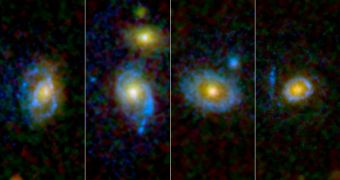A new finding shows that massive galaxies that are extremely old can be infused with new “life.” Researchers identified massive rings of ultraviolet light surrounding them, and say that these structures represent a “second lease on life” for the aging space formations.
These rings, which are only visible in the ultraviolet wavelength region of the electromagnetic spectrum, are so large that they could theoretically circle several galaxies the size of the Milky Way at the same time. Two NASA spacecraft were used for this investigation.
The important conclusion of this study is that galaxies which apparently lost their ability to produce fresh, blue stars can regain them under the right circumstances. As such, some galaxies may not be following a simple path from birth to death, but one that is laden with resurrections.
“In a galaxy's lifetime, it must make the transition from an active, star-forming galaxy to a quiescent galaxy that does not form stars. But it is possible this process goes the other way, too, and that old galaxies can be rejuvenated,” says Samir Salim.
He holds an appointment as a research scientist at the Indiana University Department of Astronomy, and is also the lead author of the new investigation. The work is detailed in the April 21 issue of the highly-regarded Astrophysical Journal, experts at the NASA Jet Propulsion Laboratory (JPL) report.
Using the NASA Galaxy Evolution Explorer at first, experts peered at old galaxies, and determined that some of them emitted too much UV light. Neither of the structures exhibited any trace of stellar formation. But the team could not discern the fine details in these galaxies using the GEX alone.
That is why they turned to the Hubble Space Telescope, whose massive observational power allowed them to observe everything they wanted in exquisite detail. The data obtained by the renowned telescope showed that some UV ring features spanned for as much as 250,000 light-years.
“We haven't seen anything quite like these rings before. These beautiful and very unusual objects might be telling us something very important about the evolution of galaxies,” says astronomer Michael Rich, who is based at the University of California in Los Angeles. He is also a coauthor of the research paper.
The California Institute of Technology in Pasadena leads the Galaxy Evolution Explorer mission and is responsible for science operations and data analysis. NASA's Jet Propulsion Laboratory, also in Pasadena, manages the mission for the NASA Science Mission Directorate, in Washington, DC. Follow me on Twitter @TudorVieru

 14 DAY TRIAL //
14 DAY TRIAL //